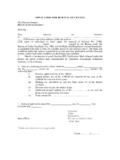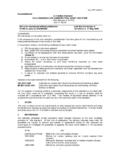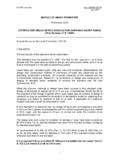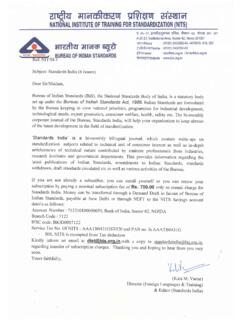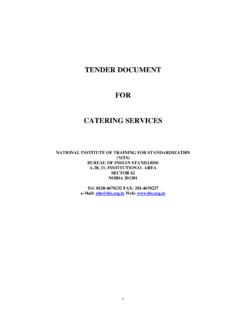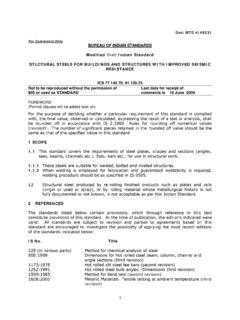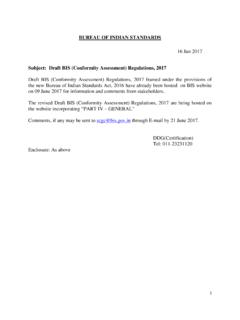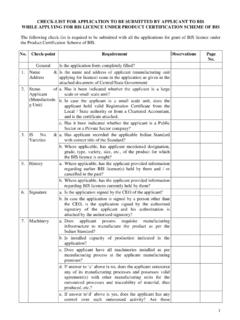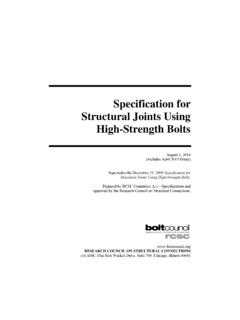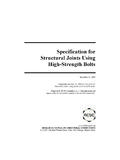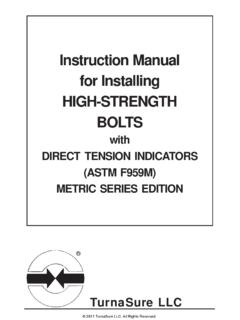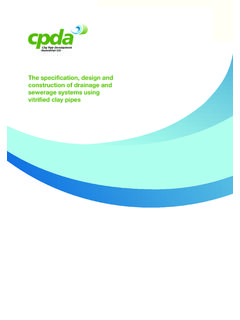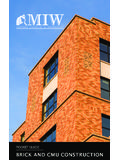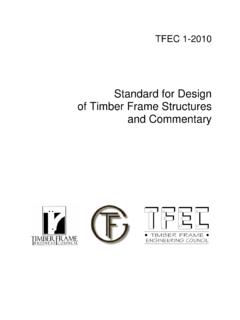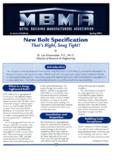Transcription of HOT ROLLED MEDIUM AND HIGH TENSILE …
1 Doc: MTD 4(5005) For Comments Only Draft Indian Standard HOT ROLLED MEDIUM AND high TENSILE structural steel ( seventh Revision of IS 2062) ICS Not to be reproduced without the permission of Last date for receipt of BIS or used as STANDARD comments is FOREWORD (Formal clauses will be added later) The Committee decided to revise the present specification to bring it in line with the international standards (EN & ASTM) on Carbon-Manganese and high Strength Low Alloy (HSLA) structural steels and also to align it as per the present practices being followed by the Indian steel industry, both in the integrated as well as secondary sectors. The specification has been made in such a way that it is now well comparable with other international standards like Euronorm and ASTM on similar grades of steel and can also be easily referred by overseas designers / customers as an alternative to the international standards.
2 In this revision, the following changes have been made: a) The title has been modified and the word low has been deleted, keeping in view the grades of steel contained in the specification. b) Amendment No. 1 has been incorporated with suitable modifications. c) Number of basic grades has been changed to nine. A new grade of E275, in line with European standard, has been incorporated to take care of the requirements of MEDIUM TENSILE structural steels in the construction segment. Moreover, for each grade two to four sub-qualities have been introduced, depending upon the grade, where sub-qualities A, BR, B0 and C, in line with other international standards, indicate the mode of killing and impact test requirements. d) The clause on Manufacture has been modified, where the scope is suitably widened to include different steel making and rolling practices in vogue.
3 E) Silicon content of semi-killed steel has been clearly specified. For all the tests specified in this standard (chemical/physical/others), the method as specified in relevant ISO Standard may also be followed as an alternate method. While revising the standard, assistance has been derived from EN 10025 & ASTM specifications. For the purpose of deciding whether a particular requirement of this standard is complied with, the final value, observed or calculated, expressing the result of a test or analysis, shall be rounded off in accordance with IS 2:1960 `Rules for rounding off numerical values (revised) . The number of significant places retained in the rounded off value should be the same as that of the specified value in this standard.
4 1 SCOPE This standard covers the requirements of steel including micro-alloyed steel plates, strips, shapes and sections (angles, tees, beams, channels, etc), flats, bars, etc, for use in structural work. The steels are suitable for welded, bolted and riveted structures and for general engineering purposes. Where welding is employed for fabrication and guaranteed-weldability is required, welding procedure should be as specified in IS 9595. Doc: MTD 4(5005) 2 REFERENCES The standards listed below contain provisions, which through reference in this text constitute provisions of this standard. At the time of publication, the editions indicated were valid. All standards are subject to revision and parties to agreement based on this standard are encouraged to investigate the possibility of applying the most recent editions of the standards indicated below: IS No.
5 Title 228 (in various parts) Method for chemical analysis of steel 808:1989 Dimensions for hot ROLLED steel beam, column, channel and angle sections (third revision) 1173:1978 Hot ROLLED slit steel tee bars (second revision) 1252:1991 Hot ROLLED steel bulb angles Dimensions (first revision) 1599:1985 Method for bend test (second revision) 1608:2005 Metallic Materials- TENSILE testing at ambient temperature (third revision) 1730:1989 steel plates sheets, strips and flats for structural and general engineering purposes (second revision) 1732:1989 Dimensions for round and square steel bars for structural and general engineering purposes (first revision) 1757:1988 Method for Charpy impact test (V-notch) for metallic material (second revision) 1852:1985 Rolling and cutting tolerances for hot- ROLLED steel products (fourth revision) 1863:1979 Hot ROLLED steel bulb flats (first revision) 1956(in various parts) Glossary of terms relating to iron and steel (in various parts) 2314:1986 steel sheet piling sections (first revision) 3803(Part 1):1989 steel Conversion of elongation values: Part 1 Carbon and low alloy steels (second revision) 3954.
6 1991 Hot ROLLED steel channel sections for general engineering purposes (first revision) 8910:1978 General technical delivery requirements for steel and steel products 9595:1996 Metal arc welding of carbon and carbon manganese steels Recommendations (first revision) 10182:(Part 1):1982 Dimensions and tolerances for hot ROLLED track shoe sections: Part 1 Sections TS 10182:(Pt 2):1985 Dimensions and tolerances for hot ROLLED track shoe sections: Part 2 Sections TS 10842:1984 Testing and evaluation procedure for Y groove crackability test 12778:1989 Dimensions for hot ROLLED steel parallel flange beam and column sections 12779:1989 Rolling and cutting tolerances for hot ROLLED parallel flange beams and column sections.
7 3 TERMINOLOGY For the purpose of this standard, the following definitions in addition to those given in the relevant parts of IS 1956 shall apply. Micro-Alloying Elements - Elements, such as niobium, vanadium and titanium added singly or in combination to obtain higher strength to weight ratio combined with better toughness, formability and weldability as compared to unalloyed steel of similar strength level. Weldability - A metallic substance is considered to be weldable by a given process and for the given purpose, when metallic continuity to a stated degree can be obtained by welding using a suitable procedure, so that the joints comply with the requirements specified in regard to both their local properties and their influence on the construction of which they form a part.
8 Controlled Rolling - A hot rolling process in which the temperature of the steel and its reduction ratio are controlled, particularly during the final rolling passes, in order to achieve fine grain micro structure and optimum mechanical properties. Normalizing Rolling - A hot rolling process in which the final rolling passes are carried out at a suitable temperature equivalent to normalizing temperature, followed by cooling in air to a temperature below the transformation temperature, in order to produce a structure, analogous to that obtained by a separate normalizing treatment of hot ROLLED product. Doc: MTD 4(5005) 4 SUPPLY OF MATERIAL General requirements relating a supply of structural steel shall conform to IS 8910.
9 5 GRADES There shall be Nine grades of steel as given in Tables 1 and 2. For grades E 250 to E 410, there shall be Four sub-qualities (A, BR, B0 & C) and for grades E 450 to E 650, there shall be Two sub-qualities (A & BR). Sub-qualities A, BR, B0 and C indicate requirement of impact test and mode of de-oxidation as indicated below: A Impact test not required, Semi-killed/Killed BR Impact test optional; if required at room temperature; Semi-killed/Killed B0 Impact test mandatory at 0 C, Semi-killed/Killed C Impact test mandatory at 20 C, Killed. While placing the order, the steel should be designated by Grade Designation & Quality (see Table 1 and Table 2). 6 MANUFACTURE steel may be supplied in semi-killed/killed condition, where killed steel shall be supplied by mutual agreement between purchaser and the manufacturer/supplier.
10 The steel may be ingot cast or continuously cast. The processes used in the steel making, casting and further hot rolling into steel plates, strips, sections, flats, bars, etc, are left to the discretion of the manufacturer/supplier. If required, secondary refining in the form of Ladle refining, Vacuum degassing may follow steel making. The products may be ROLLED and supplied in as- ROLLED /normalizing/normalizing rolling/controlled rolling/accelerated cooling conditions as per the agreement between the purchaser and the manufacturer/supplier. 7 FREEDOM FROM DEFECTS All finished steel shall be well and cleanly ROLLED to the dimensions, sections and masses specified. The finished material shall be reasonably free from surface flaws; laminations; rough/jagged and imperfect edges and all other harmful defects.
